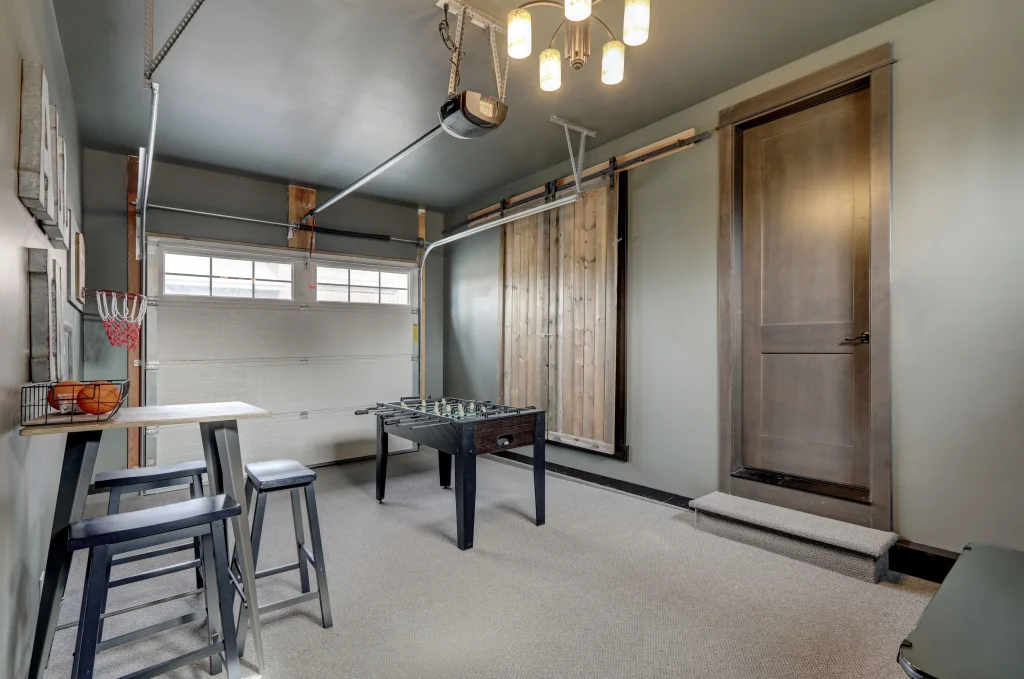
Working from home has become more and more popular over the past few years. With the rise of remote work, many people are seeking ways to optimize their home workspace and create a dedicated area for productivity. One emerging trend in California is converting garages into accessory dwelling units (ADUs) to serve as home offices. This comprehensive guide will walk you through everything you need to know about transforming your garage into a functional and inspiring home office. We have you covered from legal considerations and design tips to the construction process and optimizing your workspace.
Garage Conversions Trends in California
Garage conversions have gained immense popularity in California, particularly for homeowners looking to create additional living space or accommodate changing needs. With the increasing demand for home offices and rental units, converting garages into ADUs presents an excellent opportunity to utilize existing space effectively. Not only do these changes make the object more useful, but they also raise its value. Whether you need a dedicated work area or an extra living space, a garage conversion ADU can be the perfect solution.
Why Convert Your Garage into a Home Office?
Converting your garage into a home office offers numerous benefits, especially for those who work remotely. Here are some strong reasons to think about making this change:
- Dedicated Workspace: Converting your garage into a home office provides a dedicated and distraction-free space for work. Customizing it to meet your needs with storage and technology options can enhance productivity and focus.
- Cost Saving: Converting a garage into a home office can offer cost-saving benefits, particularly for self-employed individuals. It eliminates the need to rent external office space, reducing expenses. Additionally, working from home in a dedicated office can save commuting costs and operating fees.
- Tax Benefits: A dedicated home office can also benefit self-employed individuals. Consult with a tax professional to explore potential deductions related to your home office.
- Flexibility: A garage conversion ADU offers flexibility for changing work needs or family situations without major renovations. It provides a versatile space that can adapt to your evolving requirements.
Legal Aspects of Garage Conversions in California
Before embarking on a garage conversion project, it is crucial to understand the legal aspects and permitting requirements in your area. In California, homeowners must adhere to specific guidelines and regulations when converting a garage into an ADU. Familiarize yourself with these restrictions and requirements to ensure compliance throughout the conversion process. Additionally, consider any parking restrictions and requirements, as some jurisdictions may require additional parking structures to compensate for the loss of a garage.
Assessing Feasibility and Potential

Before starting your garage conversion project, it is essential to assess the feasibility and potential of the space. Here are some key considerations:
- Structural Evaluation: Evaluate the structural integrity of your garage to ensure it can support the necessary modifications. Consult a professional to assess the foundation, walls, and roof for any required repairs or reinforcements.
- Zoning and Permitting: Familiarize yourself with the local zoning and permitting regulations. Different jurisdictions may have specific rules regarding ADUs, setbacks, height restrictions, parking requirements, and occupancy limits. Find out about the local building codes and talk to the right people to find out what the exact rules are for your area.
- Determining Size and Layout: Determine the size and layout of your ADU based on your needs and goals for the space. Consider factors such as the number of rooms, bathrooms, and living areas required. Optimize the layout to ensure a comfortable and efficient workspace or living area.
- Maximizing Space: Garages typically have limited space, so maximizing every square foot available is crucial. Explore creative storage solutions such as built-in cabinets, shelves, and multifunctional furniture to maximize the limited square footage.
Designing the Floor Plan
Designing the floor plan is crucial in creating a functional and aesthetically pleasing home office. Consider the following factors:
- Open Floor Plan: Adopt an open floor plan design to create a sense of spaciousness and flexibility. Eliminate unnecessary walls and barriers to maximize the available space. Use dividers, curtains, or sliding doors strategically to create separate areas without sacrificing openness.
- Efficient Traffic Flow: Plan the placement of doors, windows, and furniture to ensure efficient traffic flow within the home office. Avoid any potential obstructions and create a natural flow between different areas.
- Optimizing Storage Solutions: Maximize storage options using built-in cabinets, shelves, and closets. Explore space-saving furniture options with hidden storage compartments to maximize functionality and minimize clutter.
- Incorporating Natural Light: Incorporate windows, skylights, or glass doors to allow ample natural light into the space. Natural light enhances the ambiance and visual appeal of the home office, making it feel more extensive and inviting.
- Creating Comfortable Living Zones: Designate specific living zones within the home office to maximize functionality and develop a sense of separation. Use furniture, rugs, or lighting to define areas such as a workstation, meeting space, and relaxation area.
Meeting Building Codes and Safety Standards
Meeting building codes and safety standards is crucial to ensure the safety and compliance of your garage conversion ADU. Consider the following factors:
- Fire Safety and Exits: Install smoke detectors and carbon monoxide alarms in appropriate locations throughout the ADU. Ensure that the ADU has sufficient and accessible fire exits. Use fire-rated materials and finishes in areas connected to the main living space.
- Electrical and Plumbing Considerations: Hire licensed professionals to handle the electrical and plumbing installations. Assess the existing electrical panel and upgrade it if necessary. Plan the electrical layout carefully, ensuring sufficient outlets and switches. Determine the location of water supply lines and drainage systems for plumbing installations.
- Ventilation and Insulation Requirements: Install proper ventilation systems, such as exhaust fans or mechanical ventilation, in areas prone to high humidity. Ensure adequate insulation in walls, ceilings, and floors to regulate temperature and improve energy efficiency.
Construction and Renovation Process
The construction and renovation process involves several stages. Here is an overview of the key steps:
- Hiring Professionals: Engage architects, contractors, and structural engineers to ensure a successful garage conversion ADU. They will handle the design, construction, and necessary modifications.
- Obtaining Permits and Licenses: Before starting the construction process, obtain the necessary permits and licenses required by your local building department. This includes building permits, electrical permits, plumbing permits, and any ADU-specific permits.
- Demolition and Construction: Remove existing fixtures and structures not part of the new ADU design. Construct new walls and partitions as required. Install electrical and plumbing systems. Insulate walls, ceilings, and floors. Complete the drywall installation and finish with appropriate flooring and interior design elements.
- Flooring, Finishes, and Interior Design: Choose suitable flooring materials, such as hardwood, laminate, or tile. Select appropriate finishes for walls and ceilings. Install fixtures and appliances that meet safety and building code requirements. Consider interior design elements such as furniture, lighting, and decor.
Meeting Building Codes and Safety Standards

The construction and renovation process involves several stages. Here is an overview of the key steps:
- Hiring Professionals: Engage architects, contractors, and structural engineers to ensure a successful garage conversion ADU. They will handle the design, construction, and necessary modifications.
- Obtaining Permits and Licenses: Before starting the construction process, obtain the necessary permits and licenses required by your local building department. This includes building permits, electrical permits, plumbing permits, and any ADU-specific permits.
- Demolition and Construction: Remove existing fixtures and structures not part of the new ADU design. Construct new walls and partitions as required. Install electrical and plumbing systems. Insulate walls, ceilings, and floors. Complete the drywall installation and finish with appropriate flooring and interior design elements.
- Flooring, Finishes, and Interior Design: Choose suitable flooring materials, such as hardwood, laminate, or tile. Select appropriate finishes for walls and ceilings. Install fixtures and appliances that meet safety and building code requirements. Consider interior design elements such as furniture, lighting, and decor.
Optimizing Your Home Office for Productivity
To create an optimal work environment in your home office, consider the following tips:
- Invest in Technology: Equip your home office with the necessary technology and equipment to meet your work requirements. This may include a reliable computer, high-speed internet connection, and communication tools.
- Storage Solutions: Keep your home office organized and clutter-free with smart storage solutions. Use file cabinets, shelves, and drawers to store documents, supplies, and equipment.
- Personalize Your Workspace: Make your home office inspiring and comfortable by adding personal touches. Decorate with inspiring artwork, plants, and meaningful objects that create a positive and motivating atmosphere.
- Enhance Productivity: Use smart solutions to enhance productivity. This may include ergonomic furniture, task lighting, noise-canceling headphones, and time management strategies.
The Benefits of Converting Your Garage into a Home Office

Converting your garage into a home office offers numerous benefits, including:
- Increased Productivity: A dedicated home office provides a focused, distraction-free environment, increasing productivity and efficiency.
- Cost Savings: Working from home in a converted garage eliminates the need for renting external office space, reducing expenses significantly.
- Flexibility and Convenience: A home office allows for a flexible work schedule and eliminates the need for a daily commute.
- Tax Benefits: Having a dedicated home office can provide tax benefits for self-employed individuals. Consult with a tax professional to explore potential deductions related to your home office.
- Improved Work-Life Balance: A home office provides the opportunity to achieve a better work-life balance by eliminating long commutes and allowing for more time with family and personal pursuits.
By converting your garage into a home office, you can create a dedicated space that enhances your productivity, saves costs, and provides the flexibility and convenience of working from home.
Conclusion
Converting your garage into a home office with Rhino Garage Conversion San Francisco is an excellent way to optimize your workspace and create a dedicated area for productivity. From legal considerations and design tips to the construction process and optimizing your workspace, this guide has provided a comprehensive overview of the steps in converting your garage into a functional and inspiring home office. Following these guidelines and considering your needs and requirements, you can transform your garage into a productive, comfortable space that enhances your work-life balance with Rhino Garage Conversion San Francisco.

